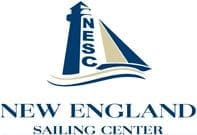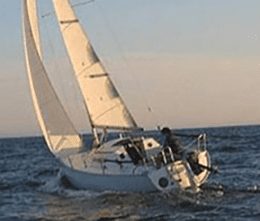Day sailing on a cruising yacht can be very rewarding as you share the joy of sailing with family and friends.
NESC offers a two day Day Sailor Cruising Certification course. The course will cover the skills for Basic Cruising with the option for ASA 103 Basic Coastal Cruising certification. Testing for the ASA Basic Coastal Cruising will provide you with International recognition of your qualifications. Your classroom will be a Beneteau 39 cruising yacht.
We have a maximum of four students in our group courses. Private lessons are also available for individuals, couples and families.
Please visit our course and certification information page for more information on pricing. Contact us to check course availability and to schedule your course.
Directions: Getting to Us
- Prerequisites: ASA 101 Basic Keelboat certification
If certifying, students must have completed the Basic Keelboat course or have comparable training to challenge the certification.
- Certification: ASA 103 Basic Coastal Cruising Certification
Students may choose to complete the ASA 103 Basic Coastal Cruising certification exam after completing the second day’s curriculum.
ASA 103 Basic Coastal Cruising certification
Curriculum for this course includes a review of terminology and sailing techniques relative to a mid-size auxiliary cruising sailboat followed by on the water training. Topics covered include auxiliary cruising sailboat systems, maneuvering under power and sail, basic coastal navigation and coarse plotting, reefing, anchoring, crew overboard, safety at sea, radio operation, weather forecast interpretation, and heavy weather techniques.
The Basic Cruising graduate will have successfully demonstrated the ability to responsibly skipper and crew an auxiliary powered cruising sailboat, during daylight hours, within sight of land in moderate wind and sea conditions.
Recommended Equipment: It is recommended that Basic Cruising Certification courses and examinations be conducted on 23′ to 32′ sloop-rigged cruising keelboats with auxiliary power and with adequate equipment inventory to complete all required certification outcomes.
Prerequisite: The prerequisite for Basic Cruising Certification is a ASA 101 Basic Keelboat Certification.
Certification Requirements: Basic Cruising Certification requires the successful completion of the following knowledge and skill requirements. These requirements are expected to be able to be performed safely with confident command of the boat in a wind range of 5 to 15 knots. Some regions may have stronger prevailing conditions, which are acceptable if the candidate can safely control the boat, and be aware of his or her limitations in these conditions. The certified candidate will be able to skipper a keelboat up to 32′ in length.
PRACTICAL SKILLS
Preparation to Sail:
Demonstrate ability to recognize and forecast prevailing local weather conditions.
Perform an inspection of running rigging, standing rigging and hull integrity.
Check the inventory, location and operation of required safety equipment.
Check the auxiliary power systems (as applicable to your boat): location and operation of engine controls, engine mechanical and fluids check, transmission controls, ventilation system and cooling system.
Check the electrical system (as applicable to your boat): main battery switch, electrical control panel and battery terminals.
Check the bilge pump system (as applicable to your boat): operation of manual and electrical pumps, intake maintenance and bilge pump alarms.
Check the head systems (as applicable to your boat): location of controls, equipment operation, holding tanks and proper setting of valves.
Check the fresh water system (as applicable to your boat): adequate quantity, operation of manual and electrical pumps, and proper setting of valves.
Check the anchoring system (as applicable to your boat): anchors, shackles, rodes, chafing equipment and windlass.
Check all other equipment specific to your boat not indicated above.
Crew Operations and Skills:
Demonstrate winch operation and the proper procedure for clearing a fouled winch.
Demonstrate tying and use of knots: clove hitch, sheet bend and rolling hitch. Review stopper knot, bowline, cleat hitch, round turn & two half hitches and square knot.
Demonstrate how to heave a line.
Demonstrate the use of sail controls: halyards, sheets, traveler, cunningham/downhaul, outhaul, adjustable backstay (if applicable), boom vang, leech lines, jib fairleads and boom toppinglift.
Demonstrate the operation of a VHF radio: operation of controls, channel usage, call sign, weather channels and simulate an emergency call.
Demonstrate a comprehensive crew briefing and plan of responsibilities.
Leaving the Dock or Mooring:
Demonstrate appropriate helmsman and crew coordination and skills for departure under power suitable to the conditions: line handling, casting off, fending off and boathandling.
Demonstrate the use of docklines, including springlines, for boat control while departing.
Demonstrate stowing of docklines and fenders.
Boat Control in Confined Waters:
Demonstrate in close quarters under power: speed and momentum control, windage and prop walk control, and command of the crew.
Demonstrate ability to maneuver under sail in close quarters: short tacking and controlled jibes.
Demonstrate a recovery plan for an engine failure in a crowded and busy harbor.
Navigation:
Determine your position in open water, the position of your destination, your intended track and approximate travel time to that destination.
Confirm your progress along that intended track with visual observations or with visual observations and electronic confirmation. Obtain and utilize relevant tide and current information. Using a chart, verify sufficient depth for a planned cruise.
Boat Control in Open Water:
Demonstrate ability to steer a compass course with changes in course to a given destination.
Demonstrate helm and boat control in a variety of wind and sea conditions.
Heavy Weather Sailing:
Demonstrate proper reefing techniques: determining when to reef, roller furling or changing headsails, reefing the mainsail, dropping sails, shaking out a reef, and rehoisting underway.
Demonstrate helm and boat control while sailing under shortened sail.
Overboard Rescue Methods:
Properly demonstrate one of the overboard rescue methods, which is most appropriate for: your sailing ability, boat type, crew experience, wind and sea conditions, and maintaining constant visual contact with the person in water.
Safety and Emergency Procedures:
Simulate procedure and operation of VHF radio in various emergency situations.
Simulate failure of steering system, and demonstrate steering and boat control with sails.
Anchoring Techniques:
Select an anchorage, and demonstrate appropriate helmsman and crew coordination and skills for properly anchoring with a single anchor under power.
Demonstrate appropriate helmsman and crew coordination and skills for retrieving your anchor under power.
Returning to the Dock or Mooring:
Demonstrate appropriate helmsman and crew coordination and skills for arrival under power suitable to the conditions: boathandling, deploying fenders, stopping and tying up.
Demonstrate correct use and deployment of docklines, including springlines.
Securing the Boat Properly:
Demonstrate stowing of sails, rigging and equipment. Thoroughly clean the boat, and install any covers and dock power equipment.
Check both the electrical and bilge systems for dock operation.
Check the locks on companionway, lockers and hatches. Make a final check of docklines, spring lines and fender placement.
KNOWLEDGE
Crew Operations and Skills:
Describe typical crew responsibilities and communications while aboard an auxiliary powered cruising sailboat.
Explain weather recognition and forecasting techniques for a day sail.
Explain the sequence for determining blocked engine cooling system circulation.
Understand the different types and operation of stoves, and fuel systems.
Be familiar with the use of a float plan.
Understand your state and local boating regulations.
Sailing Theory:
Describe sailboat dynamics: Center of Effort, Center of Lateral Resistance, and effects and influences of lee and weather helm.
Describe real and apparent wind, and their relationship to each other.
Leaving the Dock or Mooring:
Understand the effects of wind, tide and currents in relation to the boat and surrounding area, while preparing to get underway.
Describe the differences and alternatives for leaving under power in upwind, crosswind and downwind situations.
Navigation:
Understand the organization of a Mercator chart, including: latitude and longitude, chart scales, chart symbols (Chart No.1), title block, warnings, how to determine distance and direction, and the relationship between time/speed/distance.
Understand the U.S. aids to navigations (IALA System B).
Understand the magnetic influences that may disrupt compass readings.
Understand variation and describe the use of a compass rose.
Understand Digital Selective Calling (DSC) and Maritime Mobile Service Identity (MMSI).
Navigation Rules, International & Inland:
Know the Navigation Rules, International-Inland, Rules 4 through 10 for steering and sailing.
Describe the Navigation Rules, International-Inland, for Stand-On and Give-Way sailboats and powerboats for collision avoidance and understand your state and local boating regulations.
Boat Control in Open Water:
Explain the dangers of a lee shore.
Overboard Rescue Methods:
Understand the Quick-Stop, Lifesling-type, and Figure-8 overboard rescue methods under sail to include: constant visual contact with the person in water, communications, rescue plan, sequence of maneuvers, boathandling, course sailed, pickup approach and coming alongside the person in water (or simulated object).
Describe methods of getting a person in water back on deck after the vessel is stopped alongside.
Explain when overboard recovery should be done under power and the inherent dangers.
Safety and Emergency Procedures:
Describe recovery methods after going aground.
Be familiar with firefighting equipment on board: regulations, types, location and operation.
Be familiar with the location and operation of emergency steering system and boat control during failure of the steering system.
Understand towing techniques: maneuvering onto a tow, handling and securing a towline, chafing protection, boat speed, dropping off a tow and communications.
Describe the proper function of lifelines and pulpits.
Explain proper fueling techniques and potential hazards.
Explain the purpose and use of a radar reflector.
Be familiar with the U.S. Coast Guard safety requirements for auxiliary powered vessels.
Be familiar with at least six distress or emergency signals.
Anchoring Techniques:
Explain different types of anchors and various bottom conditions suited for each type.
Explain how to determine the required scope of an anchor rode.
Describe accepted etiquette when anchoring in the vicinity of other boats.
Returning to the Dock or Mooring:
Describe the differences and alternatives for arrival under power in upwind, crosswind and downwind situations.



